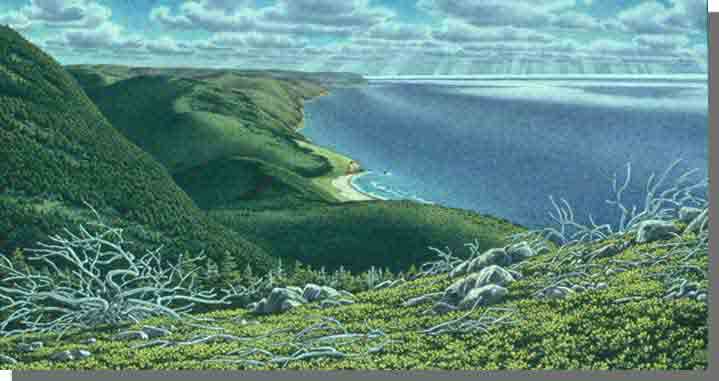 Polletts Cove – Aspy Fault Wilderness Area is Cape Breton’s largest wilderness area. From soaring headlands to forested canyons and highland barrens, it protects a spectacular mix of highland and coastal features in one of Nova Scotia’s most remote regions. Ancient faults, cirques, and canyons, combine with the forces of sea and wind to create a unique mix of habitats encompassing coastal mountain barrens, outstanding wetlands, talus slopes, old-growth hardwood canyons, and stunted spruce-fir plateau forests. Spectacular coastal cliffs extend along more than 20 km of wild coast, and 4 km of barrier beaches and several islands are protected at Aspy Bay.
Polletts Cove – Aspy Fault Wilderness Area is Cape Breton’s largest wilderness area. From soaring headlands to forested canyons and highland barrens, it protects a spectacular mix of highland and coastal features in one of Nova Scotia’s most remote regions. Ancient faults, cirques, and canyons, combine with the forces of sea and wind to create a unique mix of habitats encompassing coastal mountain barrens, outstanding wetlands, talus slopes, old-growth hardwood canyons, and stunted spruce-fir plateau forests. Spectacular coastal cliffs extend along more than 20 km of wild coast, and 4 km of barrier beaches and several islands are protected at Aspy Bay.
This remarkable range of landforms and ecosystems harbours exceptional species:
- The endangered Bicknell’s Thrush, one of Canada’s rarest and most elusive songbirds, can be found in exposed areas, along the coast or at high elevations, associated with stunted, krummholz forest.
- Arctic-alpine ecosystems, rare in Nova Scotia, occur along coastal cliffs and on high ridges. Arctic flora such as diapensia, blue mountain heather, pink crowberry, northern blueberry and alpine bilberry flourish here
- Rare maidenhair and green spleenwort ferns occur in the deep humid canyons that cut through the plateau.
- A rare and threatened aquatic lichen, known as eastern waterfan, occurs in the canyon streams. This species requires pollution free and non-acidic water to survive. It is known from only nine locations in Canada.
- Heavy snowfalls help support Canada lynx, listed as an endangered species in Nova Scotia
- The barrier beach complex on Aspy Bay is habitat for endangered piping plover.
- The islands in the sheltered North Harbour feature rich salt marshes and brackish lagoons, used by shorebirds for foraging and resting. One island is underlain by gypsum, providing high pH soil for several rare calcareous plants.
- One of the province’s largest concentrations of moose occurs in this wilderness area, attracting hunters during the popular, annual, non-motorized moose hunt.
With a long history of use by adventurers and local residents, this rugged wilderness provides excellent opportunities for remote and challenging backcountry travel, either with a local guide or on your own.
As of 2015, the Seawall Trail Society hopes to build a multi-day hiking trail here under agreement with Nova Scotia Environment.
Polletts Cove – Aspy Fault Wilderness Area was designated in 1999. It was expanded by 89 hectares in 2015, primarily with the addition of barrier beach and several islands at Aspy Bay.

